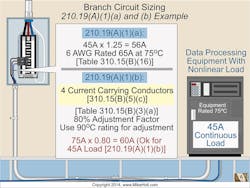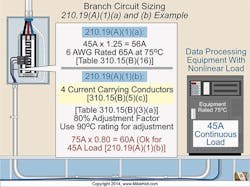Q. What is the Code requirement for sizing branch-circuit conductors?
Find the Answer
A. Branch-circuit conductors must have an ampacity of not less than the maximum load to be served. Conductors must be the larger of 210.19(A)(1)(a) or (b):
(a) Conductors must be sized no less than 125% of the continuous loads, plus 100% of the noncontinuous loads, based on the terminal temperature rating ampacities as listed in Table 310.15(B)(16).
(b) Conductors must be sized to the maximum load to be served after the application of any adjustment or correction factors.
Exception: If the assembly and the overcurrent device are both listed for operation at 100% of its rating, the conductors can be sized at 100% of the continuous load.
Equipment suitable for 100% continuous loading is rarely available in ratings under 400A. See the definition of “Continuous Load” in Art. 100. See Sec. 210.20 for the sizing requirements for the branch-circuit overcurrent device for continuous and noncontinuous loads.
Here’s an example problem that shows how to apply these Code requirements.
What size branch-circuit conductors are required for a 4-wire circuit of a 45A nonlinear continuous load, if the equipment terminals are rated 75°C?
Since the load is 45A continuous, the conductors must be sized to have an ampacity of not less than 56A (45A x 1.25). According to the 75°C column of Table 310.15(B)(16), a 6 AWG conductor is suitable, because it has an ampere rating of 65A at 75°C. This satisfies the portion of the calculation discussed in Sec. 210.19(A)(1)(a).
For 210.19(A)(1)(b), we need to address ambient temperature and conductor bundling.
Because the neutral in this example is considered a current-carrying conductor [310.15(B)(5)(c)], there are four current-carrying conductors. Table 310.15(B)(3)(a) requires an adjustment factor of 80% for this example.
6 AWG rated 75A at 90°C x 0.80 = 60A after adjustment factors, which is adequate for the 45A load (Figure). If we’d selected an 8 AWG rated 55A at 90°C, based on the 45A load, it would be too small for the load after applying the adjustment factor (55A x 0.80 = 44A).
Informational Note 4: To provide reasonable efficiency of operation of electrical equipment, branch-circuit conductors should be sized to prevent a voltage drop not to exceed 3%. In addition, the maximum total voltage drop on both feeders and branch circuits shouldn’t exceed 5%.
Many believe the NEC requires conductor voltage drop, as per Informational Note 4 to be applied when sizing conductors. Although this is often a good practice, it’s not a Code requirement because Informational Notes are only advisory statements [90.5(C)]. The NEC doesn’t consider voltage drop to be a safety issue, except for sensitive electronic equipment [647.4(D)] and fire pumps [695.7].
About the Author

Mike Holt
Mike Holt is the owner of Mike Holt Enterprises (www.MikeHolt.com), one of the largest electrical publishers in the United States. He earned a master's degree in the Business Administration Program (MBA) from the University of Miami. He earned his reputation as a National Electrical Code (NEC) expert by working his way up through the electrical trade. Formally a construction editor for two different trade publications, Mike started his career as an apprentice electrician and eventually became a master electrician, an electrical inspector, a contractor, and an educator. Mike has taught more than 1,000 classes on 30 different electrical-related subjects — ranging from alarm installations to exam preparation and voltage drop calculations. He continues to produce seminars, videos, books, and online training for the trade as well as contribute monthly Code content to EC&M magazine.


